
Griffith House, or Wright House, is a historic home located at Aberdeen, Harford County, Maryland, United States. It dates to the 18th century and is a 1+1⁄2-story, frame house measuring approximately 18+1⁄2 by 38 feet. The house is reflective of the type of dwelling of a moderately successful 18th-century farmer or planter.
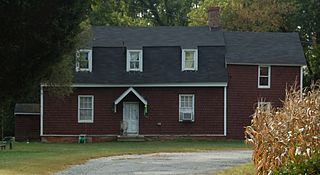
Poplar Hill is a historic home located at Aberdeen, Harford County, Maryland. It is a 1+1⁄2-story, gambrel-roofed frame house, built in the mid-18th century. A late-19th-century one-bay, two-story, gable-roofed wing is attached.

The Nelson-Reardon-Kennard House, also known as the Methodist Parsonage, is a historic home located at Abingdon, Harford County, Maryland, United States. It is a two-part frame house, with a five-bay, two-story front section built about 1785 and a three-bay, one-room rear service wing. The front porch dates to 1888. It is the oldest documented frame dwelling in Harford County.
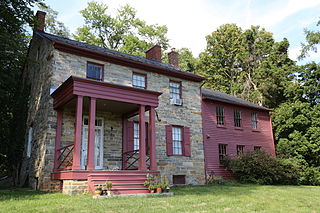
Woodside is a historic home located at Abingdon, Harford County, Maryland. It has a 2+1⁄2-story main section, designed in 1823, that is an excellent example of a Federal side hall, double parlor plan house. The house is constructed of coursed fieldstone and ashlar. The property includes a stone house with overhanging gable roof, a hand pump, a shed-roofed frame storage building, an 1848 log barn, a 1928 frame corn crib, and three early 20th century garages.

The Dibb House is a historic home located at Bel Air, Harford County, Maryland, United States. It is a 2+1⁄2-story frame house with a gable roof and a central projecting bay with cross gable. In Victorian style, it features a myriad of porches, oriels, and bay and dormer windows. Also on the property are a shed, a barn, and an outhouse.

The Hays House is a historic home located at 324 South Kenmore Avenue, Bel Air, Harford County, Maryland, United States. It is a frame 1+1⁄2-story house with a gambrel roof, likely built in 1788 with an addition in 1811. The house was moved in 1960, and stands on a modern concrete-block foundation. The Hays House is owned by The Historical Society of Harford County and today the Hays House Museum offers visitors a glimpse into the life of an affluent family in late 18th century Bel Air.

The Hays-Heighe House is a historic home located on the campus of Harford Community College near Bel Air, Harford County, Maryland, United States. It is a five bay long, two bay deep stone house with a gable roof and massive brick chimneys on each gable, built in 1808. On the east is a five bay long, two-story stone wing. Its initial owner, Thomas A. Hays, was one of the founders of the town of Bel Air.

Joshua's Meadows is a historic home located at Bel Air, Harford County, Maryland, United States. It is a three-part house: the two oldest sections are Flemish bond brick, T-shaped, gable roofed, built about 1750; and the third section is of native fieldstone and dates to 1937. The original house consists of two parts; a main 2+1⁄2-story 20-by-40-foot house and a 1+1⁄2-story 16-by-20-foot kitchen wing.
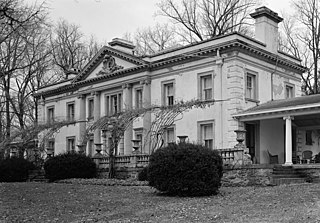
Liriodendron is a historic home and estate located at Bel Air, Harford County, Maryland, United States. It was the summer home of Laetitia and Dr Howard Kelly, a successful surgeon and founding member of the Johns Hopkins Medical College, and comprises the mansion named Liriodendron; the Graybeal-Kelly House; a c. 1835 bank barn; a c. 1898 carriage house; a c. 1850 board-and-batten cottage; and five other outbuildings including a corn crib, a smokehouse, two ice houses, and a shed. The 2+1⁄2-story, stuccoed brick mansion was designed by the Baltimore architectural firm of Wyatt and Nolting in the Georgian Revival style and constructed about 1898. The 2+1⁄2-story Georgian-style Graybeal-Kelly House, built about 1835, was the manor house for the farm until the mansion was constructed. It is used as a wedding, conference, and arts facility.
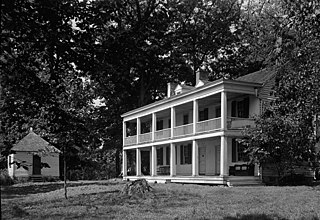
Mount Adams, also known as The Mount, is a historic home and farm complex located at Bel Air, Harford County, Maryland, United States. The complex consists of a 114-acre (46 ha) working farm, originally part of Broom's Bloom, centered on a large, multi-sectioned, 2+1⁄2-story frame house built in 1817 in the Federal style. The house has an 1850, 2+1⁄2-story cross-gabled addition, connected, but an independent unit from the main house, and slightly taller in the Greek Revival style. The property include a stone bank barn, a stone-and-stucco dairy, a stone-and-stucco privy, all dating from the early 19th century, as well as a family cemetery. Its builder was Captain John Adams Webster.
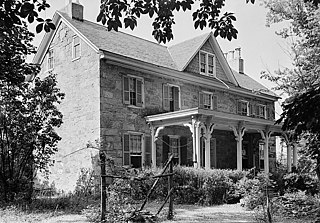
Proctor House, also known as the Cassandra Gilbert House, is an historic home located at Bel Air, Harford County, Maryland, United States. It is a two-story detached Carpenter Gothic style cottage with board and batten siding, constructed between 1860 and 1873 and enlarged about 1884. The interior features an arched slate mantel painted to resemble several colors of inlaid marble.
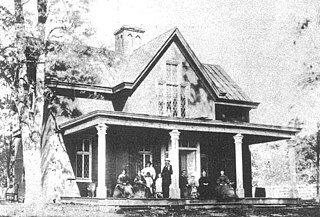
Tudor Hall is a historic home located at Bel Air, Harford County, Maryland, United States. It is a 1+1⁄2-story Gothic Revival cottage built of painted brick. The house was built as a country retreat by Junius Brutus Booth (1796–1852) from Plates 44 and 45, Design XVII, of The Architect, by William H. Ranlett, 1847. However, Booth never lived in Tudor Hall, because he died before it was completed. His son Edwin Booth lived there only briefly on his return from California before he moved the family back into Baltimore. But his other son, John Wilkes Booth, lived there with his mother, brother Joseph, and two sisters from December 1852 through most of 1856.

Rigbie House, also known as "Phillip's Purchase", is a historic home located at Berkley, Harford County, Maryland. It is a 1+1⁄2-story, frame and stone structure built about 1781. It was one of a series of forest outposts fortified against the Indians and representing Lord Baltimore’s claim of 1632 to land extending north to the 40th parallel. In April 1781, it was the place where the Marquis de Lafayette’s officers quelled a mutiny that might have prevented his army of New England troops, who had been headed homeward, from turning south again to join General Greene and General Washington at Yorktown, in which case that battle might never have been fought.

Fair Meadows is a historic home located at Creswell, Harford County, Maryland. It is a 2+1⁄2-story Second Empire–style house constructed in 1868 for the last owner of Harford Furnace, Clement Dietrich. The house is constructed of irregularly laid ashlar and features a mansard roof, cupola, dormers with rounded hoods, and stone quoins. The interior has a center hall plan and includes intricate inlay designs, black and white marble tiles in the center hall, plaster ceiling ornaments and friezes, marble mantels, and original crystal chandeliers. Also on the property are the ruins of a round springhouse, a one-story stone carriage house, a brick smokehouse, and three hip-roofed coursed rubble stone outbuildings. The estate was later home to Eastern Christian College.

Bel Air Courthouse Historic District is a national historic district at Bel Air, Harford County, Maryland, United States. It consists of a small cohesive group of buildings, mostly two or three stories of brick or frame construction that were erected or renovated in the 19th to early 20th century period and border the Harford County Courthouse which is a grand scale brick structure.

Lower Deer Creek Valley Historic District is a national historic district near Darlington, Harford County, Maryland, United States. It comprises approximately 15,020 acres (60.8 km2) in north central Harford County. The primary building material is stone taken from local quarries and used to construct houses, mills, schoolhouses, and churches. Also constructed of stone are many dependencies including springhouses, stables, tenant houses, meathouses, ice houses, and barns. The district's contributing standing structures date from the mid 18th century to the 1940s, and mostly built in vernacular styles. The valley contains approximately 350 separate historic properties.

Silver Houses Historic District is a national historic district near Darlington, Harford County, Maryland, United States. It is a group of mid-19th century farmsteads and a church in rural east central Harford County. The district comprises a total of 36 resources, including four stone residences with related agricultural outbuildings, and the site of a fifth stone house, marked by a large frame barn, a frame tenant house, and two outbuildings. The houses were built between 1853 and 1859 by members of the Silver family. The district also includes the Deer Creek Harmony Presbyterian Church, a Gothic-influenced stone building of 1871, designed by John W. Hogg.

Finney Houses Historic District is a national historic district near Churchville, Harford County, Maryland, United States. It stretches along both sides of Glenville Road in central Harford County, Maryland. The district takes in four houses and their outbuildings erected by members of the locally important Finney family between 1821 and 1906.

Medical Hall Historic District is a historic home and national historic district near Churchville, Harford County, Maryland, United States. The home was constructed of stuccoed stone between 1825 and 1840 and is five bays long, two bays wide, and two and a half stories high. The façade features a centrally placed door with sidelights and a rectangular transom subdivided in a radiating pattern. Also on the property is a stone springhouse which 20th century owners have converted into a pumphouse and a stone cottage believed to be a 19th-century tenant house. The property is associated with John Archer (1741–1810), the first man to receive a degree in medicine in America. One of his sons was Congressman, judge of the circuit court, and Chief Justice of Maryland Stevenson Archer (1786–1848).

Whitaker's Mill Historic District is a national historic district near Joppa, Harford County, Maryland, United States. It includes three early- to mid-19th-century buildings: the 2+1⁄2-story rubble stone Whitaker's Mill built in 1851, the 1+1⁄2-story rubble stone miller's house, and the log-and-frame Magness House, begun about 1800 as the miller's house for the first mill on the site. The district also includes an iron truss bridge known as Harford County Bridge No. 51, constructed in 1878, and the oldest such span in the county. The grist mill closed operations about 1900.
























